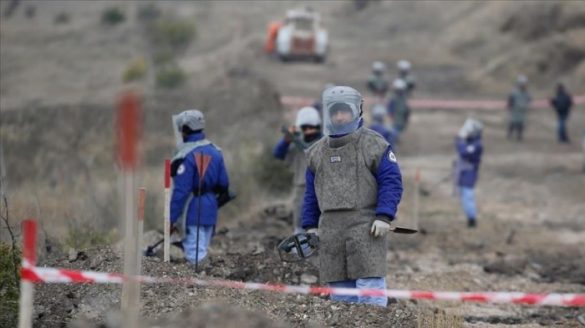Background
On 8 December 2005, the General Assembly declared that 4 April of each year shall be observed as the International Day for Mine Awareness and Assistance in Mine Action.
It called for continued efforts by States, with the assistance of the United Nations and relevant organizations, to foster the establishment and development of national mine-action capacities in countries where mines and explosive remnants of war constitute a serious threat to the safety, health and lives of the civilian population, or an impediment to social and economic development at the national and local levels.
The United Nations advocates for the universalization of existing legal frameworks and encourages Member States to expand those regimes and develop new international instruments to protect civilians from the scourges of landmines and explosive remnants of war. It undertakes this work in collaboration with interested states, civil society, mine action and international organizations. (Source: https://www.un.org/en/observances/mine-awareness-day)
Landmines planted by Armenia continue to kill and maim Azerbaijanis, said the Foreign Ministry of Azerbaijan in its twitter account.
“A mine explosion has claimed a life of another Azerbaijani serviceman today,. 288 Azerbaijanis have been struck by landmines, of whom 50 have died in the wake of the Patriotic war. The international community must voice its concern over the mine threats posed by Armenia,” the Ministry tweeted.
During the mine-clearing operations in Tartar, Aghdam, Khojavand, Lachin, Shusha, Fuzuli, Gubadli, Jabrayil and Zangilan districts, 270 anti-personnel, 656 anti-tank mines, as well as 1,465 units of unexploded ordnance (UXOs) were found and neutralized in, Azerbaijan’s Mine Action Agency (ANAMA) said in a statement in March 2023.
“As a result, nearly 5,983 hectares of territories were cleared of mines and UXOs,” the agency added.
Not providing maps of the mined areas is against the international law
After the 44-day Patriotic War, which resulted in a victory, the Republic of Azerbaijan has started large-scale construction works in the previously occupied territories and will soon implement large-scale projects. However, despite the fact that the end of the armed conflict, Armenia, still do not cooperate on planted landmine problems. A vivid example of this is the fact that the maps of mined territories have not been submitted to the Azerbaijani side.
It should be noted that the international campaign to ban landmines in general and anti-personnel mines in particular is remembered as one of the most important humanitarian initiatives at the global level.
In response to the serious humanitarian crisis resulting from the widespread proliferation of landmines, the United Nations Convention on Certain Conventional Weapons that seeks to prohibit or restrict the use of certain conventional weapons which are considered excessively injurious or whose effects are indiscriminate (Including Protocols I, II and III) was adopted on October 10, 1980 and Convention on the Prohibition of the Use, Stockpiling, Production and Transfer of Anti-Personnel Mines and on Their Destruction was adopted in Ottawa, Canada on September 18, 1997. The first Convention entered into force on December 2, 1983 and it has 125 parties, while the second Convention entered into force on March 1, 1999, and currently the number of the state-parties to this international document has reached 164 countries. Although Armenia has not signed or ratified these conventions, even the states that are not parties to these important treaties must strictly observe their provisions, guided by the fact that both mentioned conventions are based on customary international law.
In general, limitation of the use of landmines in the law of armed conflicts derives from a range of important principles that have acquired the status of a norm of international customary law.
Armenia is only showing legal irresponsibility
The first is the principle of distinction. It is well known that international humanitarian law is based on the distinction between civilians and combatants (personnel in the armed forces of the parties to the conflict).
According to Part 2 of Article 51 of Additional Protocol I “On the Protection of Victims of International Armed Conflicts” to the the Geneva Conventions of August 12, 1949 – “civilian population and individual civilians may not be the object of attack”. Paragraph ‘a’ of part 3 of article 85 of this protocol states that “making the civilian population or individual civilians the object of attack” is qualified as a serious violation of international humanitarian law and a war crime.
The point is that the use of landmines is temporary and limited only to the period of war. The end of the war necessarily includes elimination of the mine threat. Having joined the Geneva Conventions and their Additional Protocols No. I and II on June 6, 1993, Armenia is only showing legal irresponsibility, while it should comply with all legal obligations arising from those documents. To confirm this, one can refer to the violation of the most important provisions of the Vienna Convention of May 23, 1969 “On the Law of International Treaties”, which Armenia joined on May 17, 2005.
The fact that Armenia ignores the provision of Article 26 of the latter Convention, which reflects the principle of pacta sunt servanda, that “every treaty in force is binding upon the parties and must be performed by them in good faith”, is a clear example of how international law traties that define the rules of behavior for the civilized states are just an insignificant piece of paper for this state. Of course, it would be naive to expect compliance with international legal norms by Armenia, which pursues a militaristic policy, makes territorial claims to neighboring states, commits ethnic cleansing, genocide, war crimes, and crimes against humanity.
Distinction between the civilians and combatants is also reflected in the Ottawa Convention and is included in the Preamble, which is an integral part of that document. Besides Article 3, part 8 of the Protocol II on Prohibitions or Restrictions on the Use of Mines, Booby-Traps and Other Devices to the 1980 Convention prohibits the indiscriminate use of weapons that is, the use of weapons that do not distinguish between the civilian population and legitimate military targets, causing accidental deaths or injuries of civilians.
The second important humanitarian principle is proportionality. That principle is reflected in Article 51, Part 5, paragraph “b” of the Additional Protocol No. I to the Geneva Conventions, and provides that an attack which may be expected to cause incidental loss of civilian life, injury to civilians, damage to civilian objects, or a combination thereof, which would be excessive in relation to the concrete and direct military advantage anticipated are prohibited. Protocol II on prohibition of mines to the 1980 Convention mentioned above and the Ottawa Convention adopted in 1997 are based on this principle. It should also be taken into account that according to Article 9 of the same Protocol II, immediately after the cessation of active hostilities each party to the conflict undertakes to report all minefields, mined zones, mines, booby-traps and other devices. (Nizami Safarov, MP, doctor of law , Source: Modern.az)
Refusal by Armenia to provide our country with maps of mined territories should be qualified as a war crime, clearly violating the principle of distinction between the civilian population and military facilities and the principle of proportionality established in international humanitarian law. Legal confirmation of this can be found in the Statute of the International Criminal Court, which was adopted at the Rome Diplomatic Conference in 1998 and entered into force on July 1, 2002. According to the Statute, “Intentionally launching an attack in the knowledge that such attack will cause incidental loss of life or injury to civilians or damage to civilian objects, which would be clearly excessive in relation to the concrete and direct overall military advantage anticipated” (Article 8(2b, “iv”)), “employing weapons, projectiles and material and methods of warfare which are of a nature to cause superfluous injury or unnecessary suffering or which are inherently indiscriminate in violation of the international law of armed conflict” (Article 8 (2b, “xx”)) is considered a war crime and the perpetrators of these acts bear criminal responsibility.




